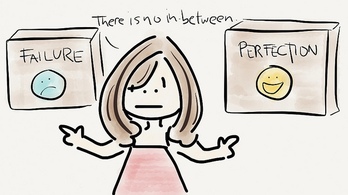Please note: This is the first of seven blogs in this "What's Your Worry Style" series. The goal of this series is to give you an overview of the variety of worry styles. Then once you know your worry style, you can ask yourself a series of questions that can challenge your thinking and work towards managing your worry habits.
This "All or Nothing" worry style is quite popular among those I work with in my practice. Simply put, this type of worrying views situations in extreme categories. For example, you may describe a project at work as either "perfect" or "horrible". In other words, folks tend to not see life in between the extremes.
Here are examples of this type of worrying:
It is not unusual for this type of thinking to lead to other serious issues such as depression, anxiety or even panic attacks. The emotional and physical toll on the human body is endless.
What to do?
1. Identify your "Worry Trigger" (WT). In other words, what set you off? There are so many things or situations that can be a Trigger. Smell, taste, sound, touch, noise, other people, objects, conversations and much more. Try to write down in your journal what your triggers are. This will be helpful when it comes time to identify the trigger(s).
2. Identify the need behind the worry. According to Abraham Maslow, the creator of "Maslow Hierarchy of Needs", we have a variety of needs in order to survive as human beings. Such as a need for water, shelter, safety, companionship, sex, food, recognition and much more. It is important to make a list of your needs so that you know what are important to you and which ones are not being met. This will come in handy when you are ready to get your needs met.
3. Learn to appreciate the "in between" the extremes: In our coaching sessions, clients learn to re-frame their thinking. Instead of saying something like "I am horrible at math", they could re frame their thinking to "I could use some help with math".
4. Practice asking questions: When we worry, we often treat our thoughts as if they are facts. Remember you are not your thoughts and your thoughts do not always look out for your best interests. Below are samples of questions you could ask yourself when you are using this style:
These steps are samples of things you can do to manage this style of worrying. Based on what you have read what did you find most useful? What will you do differently based on what you just read? Would love to hear your comments about this posting.
Stay tune for more blog posts for this series.
Worry Less, Live More,
Tom
This "All or Nothing" worry style is quite popular among those I work with in my practice. Simply put, this type of worrying views situations in extreme categories. For example, you may describe a project at work as either "perfect" or "horrible". In other words, folks tend to not see life in between the extremes.
Here are examples of this type of worrying:
- Describing yourself as a complete "failure" for overlooking a task.
- Making claims that the job market is "hopeless" when you are looking for employment.
- If your car makes a subtle unusual sound you automatically assume it will cost lots of money
It is not unusual for this type of thinking to lead to other serious issues such as depression, anxiety or even panic attacks. The emotional and physical toll on the human body is endless.
What to do?
1. Identify your "Worry Trigger" (WT). In other words, what set you off? There are so many things or situations that can be a Trigger. Smell, taste, sound, touch, noise, other people, objects, conversations and much more. Try to write down in your journal what your triggers are. This will be helpful when it comes time to identify the trigger(s).
2. Identify the need behind the worry. According to Abraham Maslow, the creator of "Maslow Hierarchy of Needs", we have a variety of needs in order to survive as human beings. Such as a need for water, shelter, safety, companionship, sex, food, recognition and much more. It is important to make a list of your needs so that you know what are important to you and which ones are not being met. This will come in handy when you are ready to get your needs met.
3. Learn to appreciate the "in between" the extremes: In our coaching sessions, clients learn to re-frame their thinking. Instead of saying something like "I am horrible at math", they could re frame their thinking to "I could use some help with math".
4. Practice asking questions: When we worry, we often treat our thoughts as if they are facts. Remember you are not your thoughts and your thoughts do not always look out for your best interests. Below are samples of questions you could ask yourself when you are using this style:
- What are you specifically predicting will happen?
- What proof do you have about your prediction?
- What is the evidence against your prediction?
- Based on the facts you generated, what would you suggest to a friend in the same scenario?
- What can you do about the situation now?
- Is your worrying hurting or helping you?
These steps are samples of things you can do to manage this style of worrying. Based on what you have read what did you find most useful? What will you do differently based on what you just read? Would love to hear your comments about this posting.
Stay tune for more blog posts for this series.
Worry Less, Live More,
Tom




 RSS Feed
RSS Feed